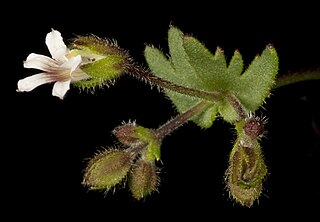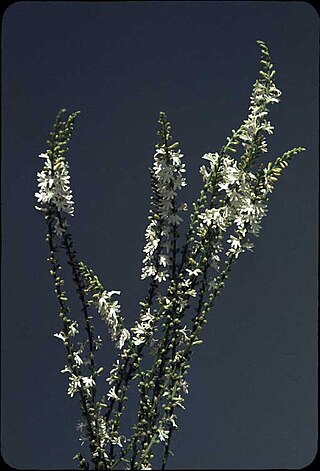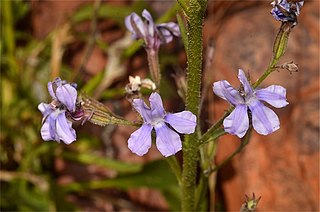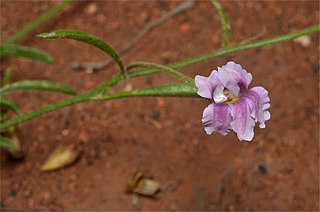
Scaevola calendulacea commonly known as dune fan-flower, is a flowering plant in the family Goodeniaceae. It is a small, mat-forming shrub with blue fan-shaped flowers with a yellow centre and grows on sand dunes in eastern and southern Australia.

Scaevola basedowii is an erect multi-stemmed shrub in the family Goodeniaceae, endemic to Western Australia, the Northern Territory and South Australia.

Scaevola browniana is a shrub in the family Goodeniaceae, endemic to Western Australia, the Northern Territory and Queensland.

Scaevola spinescens is a shrub in the family Goodeniaceae, found in all mainland Australian states and territories, in the drier parts.

Goodenia azurea, commonly known as blue goodenia, is a species of flowering plant in the family Goodeniaceae and is endemic to northern Australia. It is an erect, dense, spreading or sprawling, glaucous, perennial herb with egg-shaped leaves with the narrower end towards the base, racemes or thyrses of bluish-purple flowers with leaf-like bracts, and oval to cylindrical fruit.

Coopernookia strophiolata is a shrub in the Goodeniaceae family, endemic to Australia and found in both Western Australia and South Australia.

Goodenia cycnopotamica is a plant in the Goodeniaceae family which is endemic to Australia, and found in both South Australia and Western Australia

Goodenia glabra, commonly known as shiny pansy or smooth goodenia, is a species of flowering plant in the family Goodeniaceae and is endemic to drier inland areas of Australia. It is a prostrate to low-lying herb with lobed, oblong to egg-shaped leaves, and racemes of yellow flowers with purplish markings.
Goodenia havilandii, commonly known as hill goodenia, is a species of flowering plant in the family Goodeniaceae and is endemic to the drier parts of southern Australia. It is a prostrate to ascending, short-lived herb with sticky leaves and racemes of yellowish flowers with a brown centre.

Goodenia helmsii is a species of flowering plant in the family Goodeniaceae and is endemic to inland parts of the south-west of Western Australia. It is an erect or ascending shrub with cylindrical stem leaves and spikes of white flowers with purplish spots.

Goodenia heterochila, commonly known as serrated goodenia, is a species of flowering plant in the family Goodeniaceae and is endemic to arid areas of Australia. It is an erect or ascending perennial herb with lance-shaped to egg-shaped stem leaves with the narrow end towards the base, and racemes of yellow flowers with a brownish centre.

Goodenia hirsuta is a species of flowering plant in the family Goodeniaceae and is endemic to northern Australia. It is a hairy, prostrate to low-lying perennial herb with narrow egg-shaped leaves at the base of the plant, racemes of hairy yellow flowers and oval to elliptic fruit.
Goodenia laevis, commonly known as smooth goodenia, is a species of flowering plant in the family Goodeniaceae and is endemic to south-western Western Australia. It is a prostrate or ascending sub-shrub with oblong to lance-shaped leaves with the narrower end towards the base and racemes or thyrses of yellow flowers with purplish markings.

Goodenia lunata, commonly known as stiff goodenia, is a species of flowering plant in the family Goodeniaceae and is endemic to inland Australia. It is a ascending or low-lying herb with linear to egg-shaped leaves, small racemes of yellow flowers, and more or less spherical fruit.

Goodenia pusilliflora, commonly known as small-flower goodenia, is a species of flowering plant in the family Goodeniaceae and is endemic to drier parts of southern Australia. It is a low-lying to ascending herb with oblong to egg-shaped leaves with toothed or lyrate edges, and racemes of small yellow flowers.

Goodenia ramelii is a species of flowering plant in the family Goodeniaceae and is endemic to central Australia. It is a perennial herb with toothed, elliptic leaves in a rosette at the base of the plant, and racemes of blue flowers.

Goodenia scaevolina is a species of flowering plant in the family Goodeniaceae and is endemic to the north-west of Australia. It a perennial subshrub with egg-shaped to lance-shaped leaves, the narrower end towards the base, and thyrses of blue flowers.
Goodenia stenophylla is a species of flowering plant in the family Goodeniaceae and is endemic to the south-west coast of Western Australia. It is an erect shrub with linear or tapering leaves and racemes of white flowers with purplish spots.

Goodenia vilmoriniae is a species of flowering plant in the family Goodeniaceae and is endemic to arid areas of Central Australia. It is an ascending to erect annual herb with linear to lance-shaped leaves at the base of the plant, and racemes of pale blue to lilac flowers.

Scaevola depauperata, commonly known as skeleton fan-flower, is a species of flowering plant in the family Goodeniaceae. It is a small understorey shrub with blue, mauve or cream-white flowers. It grows in mainland states of Australia with the exception of Western Australia.




















